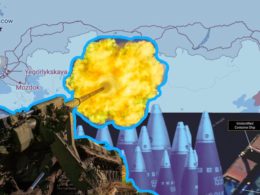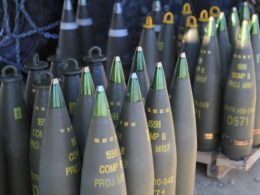After more than four months of Russia’s aggression against Ukraine, open-source data confirms that the Russian Armed Forces lost, at a minimum, over 830 tanks and 1,650 different types of armored vehicles (destroyed, damaged, abandoned or captured) as well as dozens of combat aircraft and helicopters and many other pieces of military equipment (Oryxspioenkop.com, accessed July 6). This data also does not count damaged but survived weapons systems that Russian troops were able to haul back to their bases; those systems will need a full overhaul before returning to the battlefield. Another issue Russia faces in Ukraine is a looming deficit in artillery munitions, which will become almost inevitable by the end of 2022. Indeed, the Russian reliance on mass artillery shelling raises questions about the amount of ammunition Russia still has in storage or that will need to be replaced. All these difficulties will take several years to solve, even under favorable economic circumstances.
On the eve of its re-invasion of Ukraine (launched by President Vladimir Putin on February 24, 2022), the Russian Armed Forces possessed an estimated 3,300 battle tanks, 1,900–2,000 of which were modernized or produced in 2011–2021, and no fewer than 16,000 armored vehicles of different types, a quarter of which were modernized or produced over that same decade (The Military Balance, 2022). Before 2011, Russia relied mostly on tanks and armored vehicles built in the Soviet era and had not invested much into rearmament.
Related: How Western sanctions cripple Russia’s war machine: no modern tanks, navigation systems or drones
Prior to February 24, the total number of modernized and newly manufactured tanks and armored vehicles stood at 650 (Mil.ru, 2017). No more than 160–170 improved T-72B3/B3M tanks entered service annually during 2011–2020; whereas in 2021, the military procured only 34 of these modernized versions of the T-72 (TASS, January 20, 2022). In turn, 45–50 upgraded T-80BVM tanks were added every year between 2017 and 2021 (Rostec, August 3, 2021). Annual production of the relatively advanced T-90M tanks was insignificant during this period—about ten units. And plans to upgrade T-90A tanks (built mostly in the first two decades after the breakup of the Soviet Union) to the T-90M version were delayed (Vedomosti, February 13, 2020). Consequently, even a conservative estimate of Russian main battle tank losses implies that Moscow will need at least four years to replace all of them.
However, there is another, often underappreciated problem: tank engines. The envisioned operational life of the V-84 and V-92 diesel engines used in T-72 tanks and the GTD-1000/GTD-1250 gas turbine engines used in T-80s is usually no more than 1,000 hours before they need a full overhaul. This means that most of the Russian tanks deployed in Ukraine today will need replacement engines by the end of 2022. However, for more than a decade, tank engine manufacturing in Russia has been heavily dependent on imported industrial equipment (VPK-News, July 16, 2013). The current Western embargo, thus, makes the prospects for this domestic production highly uncertain. The same kinds of issues affect the production and repair of Russian armored vehicles.
Related: War in Ukraine is worst we’ve seen, say Iraq and Afghan veterans – Foreign Legion spox
By February 24, 2022, Russia wielded around 900–1,000 combat aircraft and about 400 attack helicopters. These numbers included 130 Su-30M2/SM, 97 Su-35 and 124 Su-34 fixed-wing aircraft, as well as 130 Ka-52, more than 100 Mi-28 and over 60 Mi-35 rotorcraft, all of which were produced during the 2010s (The Military Balance, 2022). Based on these figures, Russia’s average annual manufacturing capabilities at this time were apparently limited to 30–35 combat jets and 25–30 combat helicopters.
For 2021–2027, Moscow had planned to purchase 150 new aircraft of all types, including 76 Su-57 fifth-generation fighter jets and at least 20 additional Su-34s (Vedomosti, August 11, 2021). Serial manufacturing of the Su-57’s engines will start no earlier than in 2025, however; and today, Russia’s most modern jets use engines designed for the previous generation of combat aircraft (TASS, August 9, 2021). Therefore, Russia needs to decide between following its original plan or, in light of battlefield losses and despite the Western embargo, trying to revise that plan upward in order to more quickly replace all of its lost and damaged aircraft and helicopters.
Related: To make Russia sanctions effective, West must re-establish Soviet-era watchdog COCOM – historian
Russia could also try to extend its combat air capabilities by using Yak-130 training jets as light land-attack assets. The total number of these planes is above 100, and the Russian leadership has investigated the option of sending them into battle since 2019 (Izvestia, April 20, 2021). Nevertheless, at least through the mid-2020s, Russia’s airpower capabilities will be lower than they were before the start of the full-scale aggression against Ukraine.
The Ukrainian government estimates that the attacking Russian forces are firing upward of 60,000 artillery shells per day, relying mainly on 122- and 152-millimeter rounds (The Washington Post, June 24, 2022). The number of these shells Russia has in storage is unknown as is its actual manufacturing capacity when it comes to artillery munitions. That said, open-source reporting reveals that Russia faced a deficit in artillery shells for the first time in summer 2002, following its cumulative 56-month-long campaign in Chechnya in December 1994–August 1996 and August 1999–July 2002 (Nezavisimaya Gazeta, July 5, 2002). That shortfall appeared regardless of a much lower level of artillery use in the North Caucasus (Armeiskiy Sbornik, No. 1, 2015) and despite Russia’s readiness to draw on the large Soviet-era artillery storage depots packed with ammunition that had exceeded its usable life (VPK-News, November 28, 2011).
Related: How to make sanctions really painful for Russia, immediately
Since then, Russia has tried to restart artillery shell production lines; and in 2014, it also began repairing old munitions and repaired at least 570,000 rounds of different types annually (Mil.ru, 2017). As a result, by early 2022, there may have been at least four million repaired rounds in storage. However, Russia has already likely fired more rounds in Ukraine than it repaired over all of the previous seven years. And even assuming that the manufacture of new artillery rounds presumably exceeded the number of those repaired, that ratio must be several times higher for Moscow to be able to avoid worries that its stocks may soon be empty.
Read More:
- How will UK PM Johnson’s resignation affect Ukraine?
- War in Ukraine is worst we’ve seen, say Iraq and Afghan veterans – Foreign Legion spox
- Ukraine needs the capability to attack Russian airfields – former commander US Army Europe
- Ukraine seeks $750 bn to rebuild country at Recovery Conference in Switzerland
- We should be asking what feature of Russian politics is not fascist – Timothy Snyder
- By invading Ukraine, Putin has hastened the disintegration of Russia, Etkind says
- I am a researcher, not a military man. But there is war in my country: letter from the front






